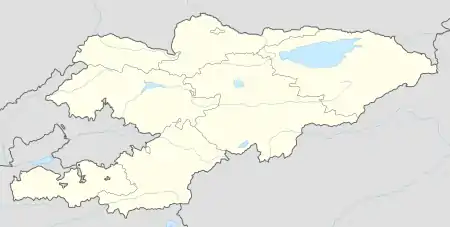Mailuu-Suu
Mailuusuu (Kyrgyz: Майлуусуу) is a mining town in Jalal-Abad Region of southern Kyrgyzstan. Its area is 120 square kilometres (46 sq mi), and its resident population was 22,853 in 2009.[1] It has been economically depressed since the fall of the Soviet Union. From 1946 to 1968 the Zapadnyi Mining and Chemical Combine in Mailuu-Suu mined and processed more than 10,000 short tons (9,100 t) of uranium ore for the Soviet nuclear program.[2] Uranium mining and processing is no longer economical, leaving much of the local population of about 20,000 without meaningful work.[3] The town was classified as one of the Soviet government's secret cities, officially known only as "Mailbox 200".[4]
Mailuu-Suu
Майлуусуу | |
|---|---|
 Seal | |
 Mailuu-Suu Location in Kyrgyzstan | |
| Coordinates: 41°14′45″N 72°26′53″E | |
| Country | |
| Region | Jalal-Abad Region |
| City Status | 1946 |
| Area | |
| • Total | 120 km2 (50 sq mi) |
| Elevation | 1,300 m (4,300 ft) |
| Population (2009) | |
| • Total | 22,853 |
| • Density | 190/km2 (490/sq mi) |
| Postal code | 721100 |
| Area code(s) | (+996) 3744 |
Uranium mills
The USSR left 23 unstable uranium tailings pits on the tectonically unstable hillside above the town.[5] A breached tailings dam in April 1958 released 600,000 cubic metres (21,000,000 cu ft) of radioactive tailings into the Mailuu-Suu River.[6] In 1994, a landslide blocked the river, which flowed over its banks and flooded another waste reservoir. A flood caused by a mudslide nearly submerged a tailings pit in 2002.[7] Mailuu-Suu was found to be one of the 10 most polluted sites in the world in a study published in 2006 by the Blacksmith Institute.[8]
The World Bank approved a US$5 million grant to reclaim the tailings pits in 2004,[7] and approved an additional $1 million grant for the project in 2011.[9] However, grave threats still persist.[10]
References
- "2009 population census of the Kyrgyz Republic: Jalal-Abad Region" (PDF). Archived from the original (PDF) on 10 August 2011. Retrieved 2011-08-10.
- Djenchuraev, N. Current environmental issues associated with mining wastes in Kyrgyzstan. Department of Environmental Sciences and Policy of Central European University, Budapest, 1999.
- Trilling, David (May 26, 2009), "Kyrgyzstan: Radioactive Legacy Vexes Bishkek", EurasiaNet, archived from the original on February 3, 2013, retrieved December 12, 2012
- Afifi, Tamer; Jäger, editors, Jill (5 August 2010). Environment, Forced Migration and Social Vulnerability. Springer Science & Business Media. p. 241. ISBN 9783642124167. Retrieved 30 December 2017.
- "Uranium in OshKyrgyzstan | Mailuu-Suu Legacy Uranium Dumps". Blacksmithinstitute.org. Retrieved 2014-01-30.
- Birsen, N.; Kadyrzhanov, Kairat K. (6 December 2012). Environmental Protection Against Radioactive Pollution: Proceedings of the NATO Advanced Research Workshop on Environmental Protection Against Radioactive Pollution Almati, Kazakhstan 16–19 September 2002. Springer Science & Business Media. p. 59. ISBN 9789400709751. Retrieved 30 December 2017.
- Sarah MacGregor (2004-02-04). "Finding a solution for uranium waste in Kyrgyzstan - OSCE Centre in Bishkek". Osce.org. Retrieved 2014-01-30.
- "Missing Controller". Blacksmith Institute. Retrieved 2014-01-30.
- "News & Broadcast - 28, 000 Inhabitants of Mailuu-Suu Valey [sic] in the Kyrgyz Republic to Benefit from Improved and Safer Access on the Road to Villages". Web.worldbank.org. 2011-06-09. Retrieved 2014-01-30.
- "Uranium in Central Asia: Poisoned legacy". The Economist. Retrieved 10 July 2015.
